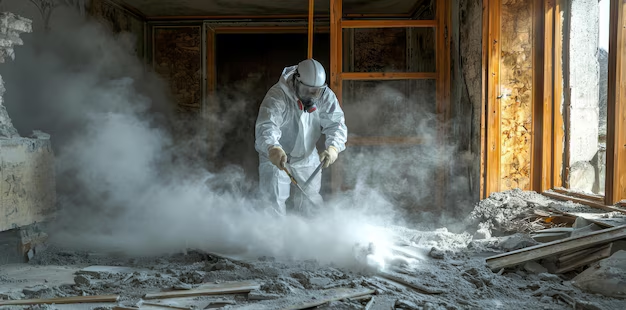
Hazmat Renovation and Demolition: Ensuring Safety During Hazardous Material Removal
Renovation and demolition projects are an essential part of construction and urban development, but they also carry significant risks—especially when hazardous materials (hazmat) are involved. Many older buildings contain harmful substances like asbestos, lead, or mold that pose serious health risks to workers, occupants, and the surrounding environment. Whether you’re renovating a commercial property or demolishing an old building, safely handling these materials is crucial to prevent exposure, environmental contamination, and legal complications.
In this blog post, we’ll explore what hazmat renovation and demolition involve, the risks associated with these projects, and the best practices for ensuring a safe and compliant process.
What is Hazmat Renovation and Demolition?
Hazmat renovation and demolition refers to the process of safely removing or managing hazardous materials from a building before or during renovation or demolition activities. These materials can include, but are not limited to:
Asbestos: A naturally occurring mineral once widely used in insulation, roofing, and flooring materials for its heat-resistant properties. When disturbed, asbestos fibers can be inhaled, leading to serious respiratory diseases like mesothelioma, lung cancer, and asbestosis.
Lead: Often found in older paint and pipes, lead is highly toxic when ingested or inhaled, especially for children and pregnant women. It can cause developmental delays, neurological damage, and organ failure.
Mold and Fungi: Mold grows in damp environments and can cause respiratory problems, allergic reactions, and other health issues when spores are inhaled. It’s particularly dangerous in confined spaces like basements and attics.
Polychlorinated Biphenyls (PCBs): These chemicals were used in electrical equipment, caulking, and paints before being banned due to their harmful effects. They can lead to skin conditions, liver damage, and even cancer.
Other Contaminants: Older buildings may also contain hazardous chemicals like mercury (from light fixtures or thermostats), radon (a naturally occurring radioactive gas), or solvents.
Renovating or demolishing a building that contains these materials requires specialized knowledge, tools, and protective measures to minimize the risk of exposure to workers and the public.
Why Is Hazmat Renovation and Demolition So Important?
Hazmat renovation and demolition is crucial for several key reasons:
Health and Safety Risks: Exposure to hazardous materials can cause both immediate and long-term health problems. For instance, asbestos exposure can lead to fatal diseases, and lead poisoning can cause developmental issues in children. Without proper handling, workers and even nearby residents can be at risk.
Environmental Protection: Improper disposal of hazardous materials can lead to serious environmental contamination. For example, asbestos fibers can spread into the air, and chemicals like PCBs can leach into soil and water. This can result in widespread pollution, endangering local ecosystems and wildlife.
Legal Compliance: In many countries, there are strict laws and regulations governing the removal and disposal of hazardous materials. Failing to comply with these regulations can result in hefty fines, legal liabilities, and potential damage to a company’s reputation.
Costly Remediation: The longer hazardous materials are left undetected or improperly managed, the more expensive and complicated the remediation becomes. Early identification and safe removal can significantly reduce the overall cost of the renovation or demolition project.
The Hazmat Renovation and Demolition Process
When dealing with hazardous materials during renovation or demolition, it’s essential to follow a structured and compliant process. Here’s an overview of the typical steps involved:
1. Pre-Demolition or Renovation Survey
Before any work begins, a thorough inspection of the building must be conducted by trained professionals. This survey is designed to identify the presence of hazardous materials like asbestos, lead, or mold. The survey should be comprehensive and consider every part of the building, including hidden areas like behind walls, under floors, and in ceilings.
Asbestos Survey: If asbestos-containing materials (ACMs) are found, samples must be taken and analyzed in a laboratory to determine the exact type and concentration of asbestos. This will help determine the necessary removal method and protective measures.
Lead Survey: Lead-based paint can be found in buildings built before 1978, the year when lead-based paints were banned in many places. A lead survey involves testing painted surfaces, plumbing, and other materials to check for lead contamination.
Mold Inspection: Mold growth is often hidden, so specialized testing equipment like moisture meters or thermal imaging cameras may be used to identify problem areas.
2. Developing a Hazardous Materials Management Plan
Once hazardous materials have been identified, a comprehensive hazardous materials management plan (HMMP) is developed. This plan outlines the steps to safely remove, handle, and dispose of the materials. The plan should include:
Removal Methods: The appropriate removal techniques for each type of hazardous material (e.g., wet methods for asbestos to prevent dust, or encapsulation for lead paint).
Containment Procedures: Procedures for containing the area to prevent contamination. This could include the use of plastic barriers, negative air pressure, and sealed rooms.
Personal Protective Equipment (PPE): The necessary PPE for workers, including respirators, protective suits, gloves, and goggles.
Waste Disposal: How the hazardous materials will be safely disposed of according to local laws and regulations. For example, asbestos waste must be sealed in leak-tight containers and transported to an approved disposal site.
3. Hazardous Material Removal and Abatement
The actual removal of hazardous materials must be carried out by certified professionals who are trained in handling these materials safely. The removal process will vary depending on the type of material:
Asbestos Abatement: This typically involves isolating the area, using wetting agents to prevent airborne fibers, and removing the materials in sealed containers. Air monitors should be used to ensure that asbestos levels remain within safe limits.
Lead Paint Removal: Lead paint may be removed through methods like chemical stripping, wet scraping, or abrasive blasting. All debris must be carefully contained and disposed of according to environmental regulations.
Mold Remediation: Mold is usually removed using HEPA-filtered vacuums, chemical treatments, and physical removal. The source of moisture must also be addressed to prevent future growth.
PCBs and Other Chemicals: PCBs and other harmful chemicals must be handled according to their specific properties and disposal regulations, often requiring specialized containers and certified disposal sites.
4. Site Clean-Up and Post-Abatement Clearance
After hazardous materials are removed, a thorough cleaning of the site is essential to ensure that no residual contamination remains. This might include cleaning surfaces, air testing, and verifying that levels of hazardous materials are below legal limits.
For some materials, like asbestos, the site may need to be inspected and cleared by an independent third-party before workers can safely return to the site.
5. Waste Disposal and Documentation
Hazardous materials must be disposed of in accordance with local, state, and federal regulations. Proper documentation should be kept for the entire removal process, including manifests, disposal receipts, and clearance certificates. This documentation is vital for legal compliance and for future reference.
Best Practices for Hazmat Renovation and Demolition
To ensure the safety of workers and the environment during hazmat renovation and demolition, here are some best practices:
Hire Certified Professionals: Always hire a licensed and experienced team to handle hazardous material removal. Many materials, like asbestos and lead, require specialized training and certifications.
Strict Adherence to Regulations: Make sure all work is compliant with local, state, and federal regulations. Failure to follow these rules can result in fines, work stoppages, and even legal action.
Use Appropriate PPE: Ensure that workers have access to proper PPE and are trained on how to use it effectively. Respirators, suits, gloves, and goggles are essential when handling hazardous materials.
Containment and Ventilation: Isolate the work area using barriers, and set up proper ventilation systems to prevent contamination from spreading to other areas.
Waste Management: Follow all regulations regarding the transportation and disposal of hazardous materials. Ensure that waste is stored and transported in sealed, labeled containers.
Conclusion
Hazmat renovation and demolition are essential for the safety of workers, the public, and the environment, especially in older buildings where hazardous materials are likely to be present. By following proper procedures and safety protocols, companies can prevent exposure to harmful substances like asbestos, lead, mold, and other chemicals, while also ensuring compliance with environmental regulations.
Whether you’re undertaking a renovation or demolition project, always prioritize safety, compliance, and thorough planning. After all, a well-executed hazmat removal project not only protects the people involved but also contributes to a healthier and safer environment for everyone.
Author
CIHP
Jay is a Certified Industrial Hygienist with over 22 years’ experience in Industrial Hygiene (Oil&Gas, Mine& Metallurgy, and Construction) and Asbestos Abatement




